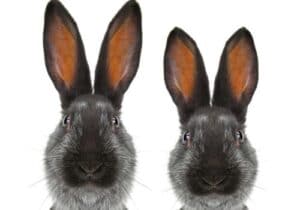
Rabbits make wonderful pets, and they’re a great addition to any home. Being able to identify the gender of a rabbit is beneficial in a number of ways.
If you’re adopting a rabbit, you should know what gender a specific rabbit is. A male bunny actually has very different personality traits than a female bunny does.
You may prefer one gender over another because of this. It’s also important to know the gender of a rabbit for breeding purposes.
If you intend on breeding your rabbit, then the gender must be known. If you want to make sure that your rabbit doesn’t breed, for the time being, you’ll want to know if you need to keep your male rabbit with other males or your female rabbit with other females.
There are a few key differences to look out for if you’re wondering how to tell the difference between a male and a female rabbit.
Key Features of a Male Rabbit
A male bunny is also known as a Buck. Contrary to popular belief, males are actually smaller than females when they’re the same age. If you’re able to pick up the rabbit, you can check for the penis.
The area above the anus must be pressed down gently for the penis to be exposed. The penis should be white or pink in color, and the testicles will remain on the inside of the body.
This is especially true in colder climates where the rabbit is outdoors. If your rabbit is indoors, you may be able to identify the gender by looking for testicles.
The testicles will not be exposed until the rabbit is at least 12 weeks old. Males will urinate more frequently than females when they are in heat. They do this in order to mark their territory.
If you talk to someone that truly knows and understands rabbits, they feel that they can identify the gender simply by looking at the face of the bunny. A face that has a slightly more block shape will indicate that the rabbit is a male bunny.
Depending on the species of rabbit, there may be some different colorings or markings that identify whether a rabbit is male or female. Some varieties of rabbits are almost impossible to identify based on how they look.
Key Features of a Female Rabbit
A female bunny is also known as a Doe. Larger in size when compared to the male, a Doe is a bit more challenging to identify.
An older Doe will have folds of skin under the neck area, but these are not prevalent until much later in life.
When you press down on the area above the anus, a female will have an exposed vagina and vulva. They do not alter their behavior during the mating season too much, but they will stay in their nest a bit more.
After the mating process has taken place, the female bunny will remain pregnant for one month. After giving birth, the female can mate again immediately.
The average size of a litter is anywhere from four to twelve babies. A baby can start to mate once they are three months old.
A female rabbit has a much more round face than a male rabbit if you feel like you can make that determination with confidence.
As the rabbit gets older, the distinction tends to be a lot more prevalent.
How to Tell the Gender of a Rabbit During Their Youth
If you have a baby rabbit on your hands and want to know what the sex is, there are some identifiers that you can look for that will assist with how to tell the gender of a rabbit. With their genitals tucked away for a number of weeks, you should be able to identify them around six weeks of age. If you are handling the bunnies before that point, you could cause the mother to reject them from your smell.
If you have a rabbit that is older than six weeks, hold them firmly while you turn them over. You need a full view of their bottom. Pull their tail out just a bit. Press down on their stomach just above the genital area. There will be one opening that is closest to the tail. This will be the anus.
The other opening that’s closest to the stomach is where you will identify their gender. If a vertical opening is present near the anus, then this is a female rabbit. If you see a small dot instead of a vertical slit, you have a male rabbit on your hands. The older the rabbit is, the easier it will be to identify them.
Pros and Cons of Male vs. Female Rabbits

It’s a good idea to understand the differences between a male rabbit versus a female rabbit.
Knowing what sex you’re dealing with can help you understand the difference between male and female rabbits’ personality traits.
This helps you provide better care for a rabbit as you identify different situations or health issues that they are dealing with. Let’s look closely at the pros and cons of each gender.
Pros and Cons of Male Bunny
Whether a male is neutered or not, they are much calmer than their female counterpart. If not neutered, they often thump their foot or run around females in order to show their interest in mating. They may also spray, which can be a hassle if your rabbit is indoors. Once neutered, this behavior will stop.
Though, it isn’t uncommon for a neutered male to occasionally display signs of thumping their foot or grunting. Males also tend to protect the females that they are around.
Pros and Cons of a Female Bunny
Female rabbits have a very territorial personality. They like to dig a lot of holes, and they can destroy items that are inside your home if you don’t watch them carefully. A female may even fake a pregnancy. They will try to build a nest using their own fur and burrow it into your furniture.
You can control this behavior to some degree by having her spayed, and this procedure will also reduce the risk of your rabbit developing uterine cancer at some point during her life. Though, females will show a much more dominant personality than you would see with a male.
Spaying and Neutering

If you don’t have the need to breed your rabbit, it’s a very good idea to have them spayed or neutered.
This will prevent any future breeding that would result in overpopulation.
Keep in mind, a rabbit that has been spayed or neutered will likely have different behavior from one that is still in heat periodically. Both males and females will behave in a much calmer manner when they are no longer able to breed.
Which Make Better Pets? A Male or Female Rabbit?
If you’re looking for a more docile rabbit that won’t display much aggression or make a lot of messes, a male bunny is likely the way to go. You can tame their behavior even more by having them neutered. Females tend to exhibit some troublesome behavior even when they have been spayed.
Of course, females make wonderful pets as well. If you take good care of your rabbit, keep them stimulated and ensure they are healthy, there won’t be many challenges to worry about.
Rabbits like to be with other rabbits, so that’s another factor to keep in mind if you’re looking to add a rabbit to your family. If you have a male rabbit, they’re going to do much better with a female rabbit.
Two males put together ends up causing some heated battles between the two of them. The only way two boy bunnies works is if one of them is much more laid back than the other.
If you are interested in weighing the options of a male or female rabbit, you can speak to a veterinarian or rabbit caretaker. There’s a lot to take into consideration when you’re looking to have a rabbit of your own.
Personality, behavior, and health concerns are just some of the things that you have to address as a rabbit owner. If you end up having a litter of rabbits, you’ll benefit from being able to identify them.
FAQ – Frequently Asked Questions
Are female or male rabbits friendlier?
Male rabbits are more mellow and easier pets for first-time caretakers. They don’t defend their territory as much, they have fewer destructive habits and usually calmer personalities!
Are male or female rabbits more aggressive?
The female rabbits are just as aggressive, if not more so than their male counterparts. This is especially true in the case of territory disputes or when a rabbit feels threatened by other animals around them and even humans interacting with it on a regular basis.
Do female rabbits have periods?
It’s important to keep in mind that female rabbits do not menstruate, and if unspayed females start passing blood they can bleed to death within a few days. Blood in the urine is also an indication of bladder stones which could be potentially life-threatening.
Can 2 male rabbits live together?
Two male rabbits may work well together, but a pair of neutered and spayed males or females are usually more successful.
Do girl rabbits hump things?
As a means of social dominance, female rabbits sometimes will hump one another.
If your doe is humping another rabbit it’s most likely because they are trying to establish their territory or hierarchy within the group.
Can 2 female rabbits live together?
While the risk of fighting between two female rabbits is higher than that of doe-buck pairings, if they are introduced slowly there’s a good chance they will get along just fine.
Both should be from the same litter for best success.
Conclusion
Do you want a rabbit that is calmer and laid back? If so, get the male. Do you want a rabbit with lots of energy and personality? Get the female!
There are pros and cons for both males and females when it comes to caring for them as well. Spaying or neutering your rabbits can help curb any unwanted behavior like spraying or aggression from either gender.
Of course, there’s plenty more information about this topic if you’re interested in learning even more about these differences between male and female bunnies.
YouTube Video About the Difference between Male and Female Rabbits
Read more about this topic
Animals.mom.com – Which Make Better Pets: Male or Female Rabbits?
Cuteness.com – Difference Between Male & Female Rabbits





